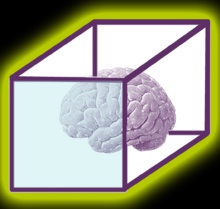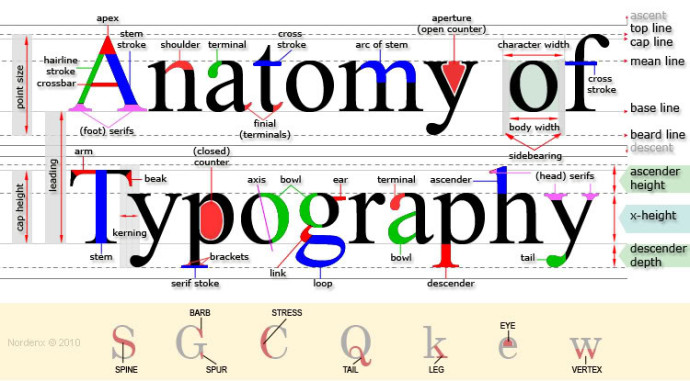
'Recognizing the need is the primary condition for design.'
Milton Glaser
Anatomy of type
Microsoft Word document [24.5 KB]
Activity 1 - Study the images, information and first presentation on this page and then complete the task below
Apply knowledge Task:
Using Power Point write your name using two different fonts in 100 point type
2 points
Now using the arrow tools and adding text boxes identify as many elements of each letter as you can. (Check the image and diagrams found below to help you)
10 points
-
 Aperture
ApertureOpening at the end of an open counter.
-
 Arm
ArmA horizontal stroke not connected on one or both ends.
-
 Ascender
AscenderAn upward vertical stroke found on lowercase letters that extends above the typeface’s x-height.
-
 Baseline
BaselineThe invisible line where letters sit.
-
 Bowl
BowlA curved stroke that encloses a letter’s counter.
-
 Counter
CounterFully or partially enclosed space within a letter.
-
 Crossbar
CrossbarA horizontal stroke.
-
 Descender
DescenderA downward vertical stroke found on lowercase letters that extends below the baseline.
-
 Diagonal Stroke
Diagonal StrokeAn angled stroke.
-
 Ear
EarA small stroke projecting from the upper right bowl of some lowercase g’s.
-
 Finial
FinialA tapered or curved end.
-
 Hairline
HairlineThe thin strokes of a serif typeface.
-
 Ligature
LigatureTwo or more letters are joined together to form one glyph.
-
 Link
LinkA stroke that connects the top and bottom bowls of lowercase double-story g’s.
-
 Loop
LoopThe enclosed or partially enclosed counter below the baseline of a double-story g.
-
 Lowercase
LowercaseThe smaller form of letters in a typeface.
-
 Serif
Serif“Feet” or non-structural details at the ends of some strokes.
-
 Shoulder
ShoulderA curved stroke originating from a stem.
-
 Small Caps
Small CapsUppercase characters that appear as a smaller size than the capital height of a typeface. Short for “small capitals”.
-
 Spine
SpineThe main curved stroke for a capital and lowercase s.
-
 Spur
SpurA small projection from a curved stroke.
-
 Stem
StemPrimary vertical stroke.
-
 Tail
TailA descending stroke, often decorative.
-
 Terminal
TerminalThe end of a stroke that lacks a serif.
-
 Uppercase
UppercaseA letter or group of letters of the size and form generally used to begin sentences and proper nouns. Also known as “capital letters”.
-
 x-height
x-heightThe height of the main body of a lowercase letter.
Content in this page is covered under (c) Creative Commons License
Activity 2 - Compare your work with the person next to you, discuss any differneces in the names you used to label your type
Activity 3 - Answer the questions below using full sentences, give examples where possible
Questions
Describe point size in your own words.
3 points
Explain what ascenders and descenders are.
4 points
Describe the 'X height' of text
3 points

